신생아들과 영아들의 원시 반사. Primitive reflexes in newborns and infants
1. 모로 반사(포옹반사) Moro reflex
- 모로 반사가 갓 태어나서부터 생후 3∼4개월까지 정상적으로 나타날 수 있다.
- 모로 반사는 인간 생명유지 행동반사이고 원시 반사이다.
- 모로 반사를 포옹반사라고도 한다. 나는 만세 반사라고 부르고 싶다.
- 신생아나 영아의 얼굴, 앞가슴은 천정을 향해 위로, 뒷머리, 등 엉덩이는 바닥을 향해 눕혀 있은 상태에서 모로 검사를 다음과 같이 할 수 있다.
- 검사하는 사람의 한쪽 손바닥으로 아기의 후두부를 약간 위로 올려 받치고 있다가 아기 뒷머리를 받쳤던 손을 갑자기 머리에서 뗀다. 이때 아기의 머리가 바닥에 까지 떨어져 부딪치지 않게 바닥을 향해 아기머리를 갑자기 뚝 떨어지게 머리에 댔던 손바닥을 뗄 때 모로 반사가 생긴다.
- 아기는 좌우 상지를 맨 처음 몸통의 좌우 옆을 향해→머리 쪽 위로 향해 활짝 폈다가→곧 바로 활짝 폈던 양 팔을 몸통의 앞으로 가져오고→원래 있던 자세로 돌아오는 동작을 취한다.
- 마치 두 팔을 갑자기 번쩍 들고 만세를 하고 난 후 두 팔로 누구를 껴안으려하는 것 같은 자세를 취한다.
- 이런 일련의 자세를 갑자기 같은 움직임으로 취한다.
- 이 반사를 모로 반사, 포옹반사,”만세반사”라고 한다.
- 모로 반사가 나타날 때 양손과 모든 손가락들을 활짝 편다.
- 위에서 설명한 것같이 모로 반사가 나타날 때는 양 상지를 대칭적으로 움직이는 것이 보통이다.
- 모로 반사는 태어나서부터 생후 3∼4개월경까지 있다가 자연적으로 없어진다.
- 모로 반사는 0∼4개월 된 건강한 신생들이나 영아들에게 정상적으로 나타나는 정상적인 원시 반사이다.
- 모로 반사가 신생아들이나 영아들에게 나타날 때 부모들, 특히 초보 맘들은, 신생아나 영아가 무엇으로 놀래서 그런 자세를 취한다고 걱정하기도 한다.
- 때로는 쓸데없이 약물로 치료 한다.
- 모로 반사는 옷을 입힐 때도 신생아들에게 생길 수 있다.
- 갑자기 큰 소리로 자극 받을 때도 생길 수 있다.
- 신생아가 배를 바닥에 대고 누워 있을 때는 모로 반사가 거의 생기지 않는다.
표 신생아들이나 영아들에게 나타나는 원시 반사
| 원시 반사의 종류 | 처음 나타나는 나이 | 없어지는 나이 |
| 긴장성 경반사(목 긴장성 반사/긴장성 목 반사) Tonic neck reflex) | 임신 28주 태아 | 생후 7~8개월 |
| 모로 반사(포옹 반사/ 만 세 반사) Moro reflex) | 임신 20주 태아 | 생후 7~8개월 |
| 파악 반사(움켜잡기 반사) Grasp reflex | 임신 28주 태아 | 생후 2~3개월 |
| 몸통 굴곡 반사 (Trunk in -curve refex) | 임신 28주 태아 | 생후 3~4개월 |
| 돌 눈 반사 (Doll’s eye reflex) | 임신 32주 태아 | 생후 4~5개월 |
| 바빈스키 반사 (Babinski reflex) | 임신 38 주 태아 | 생후 10일 |
| 보행 반사 (Walking reflex) | – | 생후 12~16개월 |
| 플레이싱 반사(위치 반사) Placing reflex) | 출생 시 | – |
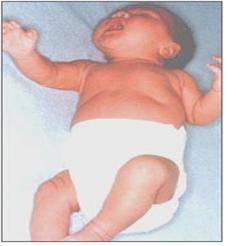
사진 2-78. 영아에게 나타난 모로 반사
좌우 상지를 몸통의 양쪽 옆으로 향해 활짝 펴기 시작한다.
Copyright ⓒ 2011 John Sangwon Lee, MD., FAAP
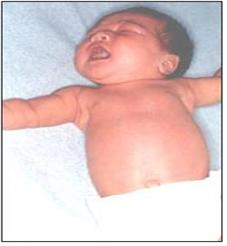
사진 2-79. 모로 반사
좌우 상지를 몸통 양쪽 옆으로 향해 활 짝 폈다. 이 영아는 영아산통으로 많이 운다. 많이 먹어서 배가 부른 것도 사진에서 볼 수 있다.
Copyright ⓒ 2011 John Sangwon Lee, MD., FAAP
- 얼굴이 천장을 향하게 하고 등이 바닥에 대게 한 체위로 신생아나 영아를 눕힐 때 모로 반사가 더 잘 생긴다.
- 모로 반사가 신생아나 영아가 부모 품에서 떨어지기 싫다는 것을 부모에게 알려 주기 위해 나타나는 것 같다.
- 모로 반사가 나타날 때 아기를 바로 꼭 안아 주든지 담요로 꼭 싸서 잠자리에 눕히든지 아기의 손, 팔, 다리, 몸통을 포근히 잡아주면 모로 반사가 즉시 멈추는 것이 보통이다.
- 이런 모로 반사는 생후 3∼4개월경까지 나타나다가 그 이후부터 더 이상 나타나지 않는 것이 정상이다.
- 신생아나 영아에게 모로 반사나 긴장성 경반사가 나타날 때 아기가 놀래 그런 현상이 생긴다고 걱정하는 부모도 있다.
- 모로 반사는 몸 양쪽 대칭적으로 생기지만 그 한쪽 팔에만 모로 반사가 나타나면 한쪽 팔이나 어깨, 또는 쇄골 등에 골절이 있을 수 있다.
- 몸 양쪽 중 한쪽 신경 이상이 있나 알아봐야 한다.
- 모로 반사는 대칭적으로 나타나는 것이 정상이다.
출처 및 참조문헌
- Growth and Development of Children, George H. Lowrey 8th edition, p.148
- Nelson textbook, 15 edition
- The Johns Hopkins Hospital, The Harriet Lane Handbook, 18th edition, p.264-265
2. 흡철 반사(빨기 반사/흡인 반사) Sucking reflex
- 입 안에 무엇을 넣고 빠는 반사를 흡철 반사, 빨기 반사, 또는 흡인 반사라고 한다.
- 흡철 반사는 태어나서부터 생후 4∼7개월경까지 나타난다.
- 흡철 반사는 정상적으로 나타나는 인간 생명유지 행동반사의 일종이다.(p.00 모로 반사 참조).
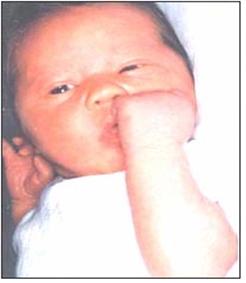
사진2-81.신생아는 손가락 등 거의 무엇이든 입안에 넣고 빨 수 있다. 이런 반사를 흡철 반사라고 한다. 이 반사가 있기 때문에 무엇을 빨고 있는 신생아나 영아를 보고 배가 고파서 손가락을 빨고 있는 줄로 잘못 아는 부모들이 많다. 배가 고플 때는 이 반사는 더 현저히 나타나는 것이 보통이다(구순기 참조).
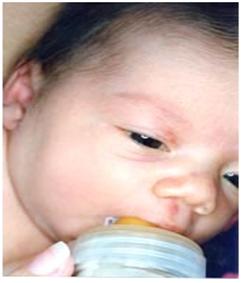
사진2-82.신생아들은 손가락 등 거의 무엇이든 입안에 넣고 빨 수 있다. 이런 반사를 흡철 반사라고 한다.
이 반사로 무엇을 빠는 신생아를 보고 배가 고파서 손가락을 빠는 줄로 잘못 아는 부모들이 많다. 배가 고플 때는 이 반사는 더 현저히 나타나는 것이 보통이다.
3. 구역 반사와 구토 반사 Gag reflex and vomiting reflex
- 먹어서는 안 될 것이 입 안에 들어오거나 음식물을 삼키기 싫을 때 구기가 생기고 구토할 수 있다.
- 이런 원시 반사를 구역 반사 또는 구토반사라고 한다.
- 이런 반사는 신생아들이나 신생아기 이후 영유아, 학령기와 사춘기 아이, 또는 성인에게도 정상적으로 나타날 수 있다(p.00 모로반사 참조).
- 인간 생명유지 행동반사의 일종이다.
4. 재채기 반사 Sneeze reflex
- 몸에 해로운 먼지나 항원 등이 콧구멍을 통해서 비강 속으로 들어 올 때 그 것을 콧구멍을 통해 몸 밖으로 내보내려고 하는 원시 반사를 재채기 반사라고 한다.
- 이런 반사는 정상적으로 나타날 수 있다.
- 인간 생명유지 행동반사의 일종이고 원시 반사이다.
5. 하품 반사 Yawn reflex
- 하품을 하는 반사를 하품 반사라고 한다.
- 잠자고 싶을 때, 피로할 때 하품 반사가 생길 수 있다.
- 이 반사는 정상적으로 나타나는 원시 반사이고 인간 생명유지 행동반사의 일종이다.
6. 파악 반사(움켜잡기 반사) Grasp reflex
- 신생아나 생후 2∼3개월 영아의 손바닥에 엄마 아빠의 손가락을 갖다 대면 손가락과 손바닥을 꼭 오므려 자기 엄마 아빠의 손가락을 꼭 잡는다.
- 이런 반사를 파악 반사라고 한다.
- 파악 반사는 원시 반사의 일종이고 인간 생명유지 행동반사이다.
- 이 파악 반사는 생후 3~4개월 지나면 자연히 없어진다.

사진 2-83.신생아나 생후 2∼3개월 된 영아의 손바닥에 엄마 아빠의 손가락을 대면 자기의 손가락과 손바닥을 꼭 오므려 자기 손바닥에 닿는 엄마나 아빠의 손가락을 꼭 잡는다. 이런 반사를 파악반사라고 한다.
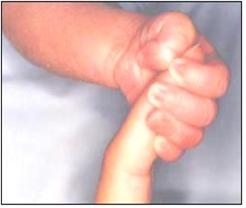
사진 2-84.신생아나 생후 2∼3개월 된 영아의 손바닥에 엄마 아빠의 손가락을 대면 자기의 손가락과 손바닥을 꼭 오므려 자기 손바닥에 닿는 엄마 아빠의 손가락을 꼭 잡는다. 이런 반사를 인간 생명유지 행동반사라고도 한다.
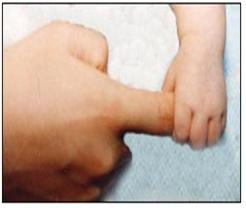
사진2-85.신생아가 무의식적으로 엄마의 손가락을 잡고 있다. 이런 반사를 파악 반사라고 한다. 여기서 엄마와 자식도 신체적 접촉사랑을 하고 있다.

사진2-86.신생아가 무의식적으로 엄마의 손가락을 잡고 있다. 이런 반사를 파악 반사라고 한다.
7. 긴장성 경반사(목 긴장성 반사/긴장성 목 반사) Tonic neck reflex
- 신생아나 생후 2개월 된 영아의 머리를 한쪽으로 갑자기 돌릴 때 머리의 뒤통수가 있는 쪽 팔 다리는 오므리고, 턱이 있는 쪽 팔 다리를 뻗쳐서 마치 펜싱을 하는 자세를 취하는 원시 반사를 긴장성 경반사라고 한다.
- 이 반사는 생후 2주경에 나타내기 시작해서 생후 6~8 개월경 자연히 없어진다.
- 신생아나 영아에게 나타나는 이러한 긴장성 경반사 및, 또는 모로 반사가 생길 때 신생아나 영아가 놀래서 생기는 현상이라고 걱정하는 부모도 있다.
- 긴장성 경반사는 정상적 원시 반사이고 인간 생명유지 행동반사의 일종이다.

사진 2-87.긴장성 경반사
머리의 뒤통수가 있는 쪽 팔과 다리는 오므리고, 그 반대쪽, 즉 턱이 있는 쪽 팔과 다리를 뻗쳐서 마치 펜싱하는 자세를 취하는 반사를 긴장성 경반사라 한다. 이 반사는 생후 2주 경 나타나기 시작해서 생후 6~8개월 경 자연히 없어진다.
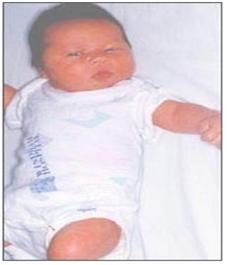
사진 2-88.긴장성 경반사
머리의 뒤통수가 있는 쪽 팔과 다리는 오므리고, 그 반대쪽, 즉 턱이 있는 쪽의 팔과 다리를 뻗쳐서 마치 펜싱을 하는 자세를 취하는 반사를 긴장성 경반사라 한다. 이 반사는 생후 2주 경 나타나기 시작해서 생후 6~8개월 경 자연히 없어진다.

사진 2-89.2주 된 신생아가 긴장성 경반사를 나타내고 있다.

사진 2-90.3주 된 신생아가 긴장성 경반사를 나타내고 있다.
8. 포유 반사(루팅 반사) Rooting reflex
- 엄마의 유방이나, 우유병 꼭지, 노리개 젖꼭지, 그 외 부드러운 것이 신생아나 영아의 뺨이나 입술부위에 닿을 때 아기의 뺨이나 입술 또는 그 주위 부위에 닫는 것이 있는 쪽으로 입을 돌리고 먹으려고 하거나, 또는 엄마 젖 냄새가 나는 쪽으로 얼굴과 입을 돌려 먹으려고 하는 반사를 루팅 반사, 또는 포유 반사라고 한다.
- 인간 생명유지 행동반사이고 원시 반사의 일종이다.

사진 2-91.엄마의 젖꼭지를 찾아 젖을 먹으려하는 루팅 반사(포유반사).
손가락이 엄마의 젖꼭지 인줄 알고 영아가 그 손가락이 있는 쪽으로 입과 머리를 돌리고 있다.
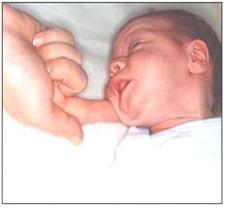
사진2-92.엄마의 젖꼭지를 찾아 젖을 먹으려하는 루팅 반사(포유반사).
2개월 된 영아가 손가락이 엄마의 젖꼭지인줄 알고 영아가 그 쪽으로 입과 머리를 돌리고 있다.
9. 견인 반사 Traction reflex
- 신생아나 영아의 좌우 두 손을 동시 잡고 머리 등 엉덩이를 바닥에 대고 누워 있는 자세에서 위를 향해 아기를 일으킬 때 머리가 처음에는 뒤로 쳐지다가, 신체가 곧게 수직으로 유지될 때는 목에 힘을 주어 머리를 잠시 동안 꼿꼿이 세우고 상지의 근육에도 힘을 주는 원시 반사를 견인 반사라 한다.
- 인간 생명유지 행동반사의 일종이다.
10. 보행 반사 Walking reflex
- 아기의 몸통을 양쪽 손으로 붙들고 세운 자세에서 아기의 발바닥을 바닥에 대면 걷는 동작과 비슷하게 발작을 떼는 자세를 취한다.
- 이런 자세를 취하는 것을 보행 반사라고 한다.
- 이것도 원시 반사의 일종이고 인간 생명유지 행동반사이다.
11. 위치 반사(플레이싱 반사) Placing reflex
- 아기의 몸통을 양손으로 붙들어 세우고 아기의 발등을 책상 모서리에 댈 때 댄 쪽 무릎을 굽히고 발을 들어 책상 위로 올려놓으려는 원시 반사를 플레이싱 반사, 또는 위치 반사라고 한다.
- 인간 생명유지 행동반사의 일종이다.
12. 낙하산 반사(낙하산 반응) Parachute reflex
- 영아의 몸통의 양쪽을 양손으로 붙들고 갑자기 떨어뜨리는 시늉을 하면 영아가 자연적으로 양쪽 상지를 뻗혀 얼굴의 상처를 나지 않게 하는 원시 반사를 낙하산 반사 또는 낙하산 반응이라 한다.
- 이 반사는 생후 5-6개월경 나타난다.
- 이 원시 반사는 일생동안 정상적으로 계속 있다.
- 낙하산 반사도 인간 생명유지 행동반사의 일종이다.
13. 눈 깜박 반사(순목 반사) Blinking reflex
- 눈에 이물이 들어온다든지 안구 쪽으로 해로운 것이 들어오려고 할 때 안구 손상을 방지 하기위해 눈을 감는 원시 반사를 눈 깜박 반사 또는 순목 반사라고 한다.
- 이 반사도 일종의 원시 반사이다.
- 신생아에게 눈 깜박 반사가 정상적으로 나타날 수 있다.
- 이 반사는 일생동안 계속 있는 것이 정상적이다.
- 눈 깜박 반사도 인간 생명유지 행동반사의 일종이다.
- 정상적 반사의 일종이다.
14. 그 외 원시 반사
Primitive reflexes in newborns and infants 신생아들과 영아들의 원시 반사
1. Moro reflex (hug reflex)
- Moro reflex can appear normally from newborn to 3-4 months of age.
- The Moro reflex is a behavioral reflection that sustains human life and is a primitive reflection.
- Moro reflex is also called hug reflection. I want to call it to hurray reflection.
- You can perform the Moro test as follows with the face of a newborn or infant with the front chest facing the ceiling and the back of the head, and the buttocks of the back lying on the floor.
- While holding the baby’s occipital part slightly upward with one palm of the examiner, the hand that supported the baby’s back head suddenly removed from the head.
- At this time, when the baby’s head suddenly falls to the floor so that the baby’s head does not fall to the floor and the palm of the head is removed, a reflection occurs.
- The baby moves the upper left and right upper limbs first to the left and right sides of the torso→towards the head side and then spreads them wide open→rightly opens both arms in front of the torso→returns to the original posture.
- After hurraying with both arms suddenly raised, he takes a pose as if he is trying to hug someone with both arms.
- Suddenly, you take this series of postures in the same movement. This reflection is called the Moro reflex, the hug reflection, and the “Hurray reflection”.
- When the Moro reflex appears, open both hands and all fingers wide. As explained above, when Moro reflex appears, it is common to move both upper limbs symmetrically.
- Moro reflex occurs from birth to about 3-4 months of age, and then disappears naturally. The Moro reflex is a normal primitive reflex that normally appears in healthy newborns or infants aged 0-4 months.
- When the Moro reflex appears in newborns or infants, parents, especially novice moms, worry that the newborn or infant is surprised by something and takes that position. Sometimes it’s uselessly treated with drugs.
- Moro reflex can also occur in newborns when dressed.
- It can also occur when suddenly and loudly stimulated.
- When a newborn baby is lying on the floor with her tummy, there is almost no reflex.
Table Primitive reflexes in newborns and infants 표 신생아들이나 영아들에게 나타나는 원시 반사
| Types of primitive reflexes | First appearing age | Disappearing age |
| Tonic neck reflex | 28 weeks pregnant fetus | 7 to 8 months after birth |
| Moro reflex | 20 weeks pregnant fetus | 7 to 8 months after birth |
| Grasp reflex | 28 weeks pregnant fetus | 2 to 3 months after birth |
| Trunk in -curve reflex | 28 weeks pregnant fetus | 3 to 4 months after birth |
| Doll’s eye reflex | 32 weeks pregnant fetus | 4 to 5 months after birth |
| Babinski reflex | 38 weeks pregnant fetus | 10 days after birth |
| Walking reflex | – | 12 to 16 months after birth |
| Placing reflex | at the birth | – |
Fetus 2-3 months after birth Trunk in-curve refex 28 weeks pregnant fetus 3-4 months old Doll’s eye reflex: 32 weeks gestation, fetus 4-5 months after birth Babinski reflex Fetal at 38 weeks of pregnancy 10 days after birth Walking reflex-12 to 16 months of age Placing reflex (Place reflex) At birth- Photo 2-78. Moro reflection in infants Begin to spread the left and right upper limbs toward both sides of the torso. Copyright ⓒ 2011 John Sangwon Lee, MD., FAAP

Photo 2-79. Morrow reflex
Spread the left and right upper limbs toward both sides of the torso. This infant cries a lot due to infantile colic. You can also see in the photo that I was full because I ate a lot. Copyright ⓒ 2011 John Sangwon Lee, MD., FAAP
- Moro reflexes are more pronounced when a newborn or infant is laid in a position with the face facing the ceiling and the back on the floor.
- The Moro reflex appears to appear to remind parents that a newborn or infant does not want to fall out of their arms.
- When the Moro reflex appears, it is common for the Moro reflex to stop immediately if you hold the baby tightly, wrap it tightly in a blanket and lay it to bed, or hold the baby’s hands, arms, legs, and torso. It is normal for these Moro reflexes to appear until about 3-4 months of age, and then no longer appear thereafter. Some parents worry that when a newborn or infant has a Moro reflex or tension globular reflex, the baby is surprised and the phenomenon occurs.
- The Moro reflex occurs symmetrically on both sides of the body, but if the Moro reflex appears on only one arm, there may be a fracture in one arm, shoulder, or collarbone. You need to find out if there are any nerves on either side of your body. It is normal for the Moro reflection to appear symmetrically. Sources and references Growth and Development of Children, George H. Lowrey 8th edition, Nelson textbook, 15 edition The Johns Hopkins Hospital,
- The Harriet Lane Handbook, 18th edition, p.264-265 2. Sucking reflex (sucking reflection/sucking reflection)
- The reflex that puts something in the mouth and sucks it is called the sucker reflex, the sucker reflex, or the aspiration reflex.
- The absorption iron reflex appears from birth to around 4-7 months of age. The absorbent reflex is a kind of behavioral reflection that sustains human life normally (refer to Moro Reflex).

Picture 2-81. Newborn babies can sucking almost anything, such as fingers, in their mouths. This reflex is called the absorption iron reflection. Because of this reflex, many parents mistakenly believe that they are sucking their fingers because they are hungry to see a newborn or infant sucking something. When hungry, these reflexes are usually more pronounced (see Oral Order).

Picture 2-82. Newborns can sucking almost anything, such as fingers, in their mouths. This reflection is called the absorption iron reflection. Many parents mistakenly believe that they are sucking their fingers because they are hungry when they see a newborn sucking something with this reflex. When hungry, this reflection is usually more pronounced.
3. Gag reflex and vomiting reflex
- When something you shouldn’t eat gets in your mouth or when you don’t want to swallow food, you can get goo and vomit. This primitive reflex is called regional reflex or vomit reflex.
- These reflexes can also appear normally in newborns or post-natal infants, school-age and adolescent children, or adults (see Moro Reflex). It is a kind of behavioral reflection that sustains human life.
4. Sneeze reflex
- When dust or antigens that are harmful to the body enter the nasal cavity through the nostrils, the primitive reflex that tries to send it out of the body through the nostril is called the sneeze reflex.
- These reflections can appear normal. It is a kind of behavioral reflection that sustains human life and is a primitive reflection.
5. Yawn reflex
- The yawning reflex is called the yawning reflex. Yawning reflexes can occur when your baby wants to sleep or when you are tired.
- This reflection is a primitive reflection that appears normal and is a kind of behavioral reflection that sustains human life.
6. Grasp reflex
- Grasp reflex If you place your mother’s and dad’s fingers on the palm of a newborn baby or an infant from 2 to 3 months of age, hold her fingers and palms tightly to hold the fingers of your mother and father. These reflections are called grasping reflections.
- Grasping reflex is a kind of primitive reflex and human life-sustaining behavioral reflection. This grasping reflex disappears spontaneously after 3-4 months of age.

Photo 2-83. When she puts her mom’s and dad’s fingers on the palm of a newborn baby or an infant 2 to 3 months old, close her fingers and palms to hold the mom’s or dad’s fingers that touch their palms. This reflection is called grasping reflex.

Photo 2-84. When you place your mom and dad’s finger on the palm of a newborn baby or an infant 2 to 3 months old, close your fingers and palm tightly to hold the mom and dad’s finger that touches your palm. These reflections are also called human life-sustaining behavioral reflections.

Picture 2-85. A newborn baby is holding her mother’s finger involuntarily. These reflexs are called grasping reflections. Here, the mother and child are also in physical contact with love.

Picture 2-86. The newborn child is holding her mother’s finger involuntarily. These reflexs are called grasping reflections.
7. Tonic neck reflex
When the head of a newborn baby or a 2-month-old infant is suddenly turned to one side, the limb on the back of the head is closed, and the limb on the side of the chin is stretched and the primordial reflex in a fencing posture is called tonic neck reflex. This reflex begins to appear around 2 weeks of age and disappears naturally around 6 to 8 months of age. Some parents are concerned that this tension globular reflex in newborns and infants, or the phenomenon of surprise in the newborn or infant when the Moro reflex occurs. The nervous tension reflex is a normal primitive reflex and is a kind of behavioral reflex that sustains human life.

Photo 2-87. Tonic neck reflex
The reflex in which the arms and legs on the back of the head are constricted and the arms and legs on the opposite side, that is, on the side with the chin, are stretched to form a fencing posture, is called tonic neck reflex. This reflex begins to appear around 2 weeks of age and disappears spontaneously around 6 to 8 months of age.

Photo 2-88. Tonic neck reflex
The reflex that takes the posture of fencing by constricting the arm and leg on the side of the head with the back of the head, and extending the arm and leg on the opposite side, that is, the side with the chin, is referred to as a tonic neck reflex. This reflex begins to appear around 2 weeks of age and disappears spontaneously around 6 to 8 months of age.

Photographs 2-89.2 weeks old newborns show tonic neck reflex.

Picture 2-90.3-week-old newborn baby exhibits tonic neck reflex.
8. Rooting reflex
• When the mother’s breast, milk bottle nipple, soother, or other soft object comes into contact with the newborn’s or infant’s cheeks or lip, turns the mouth toward the baby’s cheek or lip or something close to it, or attempts to eat, or The reflex that tries to eat by turning the face and mouth toward the smell of milk is called the rooting reflex, or the mammalian reflex.
• It is a behavioral reflection that sustains human life and is a kind of primitive reflection.

Picture 2-91.tRooting reflex trying to find and breastfeed mother’s nipples. Thinking that the finger is the mother’s nipple, the infant is turning his mouth and head toward the finger.

Picture 2-92. Rooting reflex trying to find mother’s nipples and breastfeeding (mammal reflection). A two-month-old infant knows that her fingers are mother’s nipples, and the infant turns his mouth and head towards him.
9. Traction reflex
• When holding the left and right hands of a newborn baby or infant at the same time and raising the baby upwards in a position lying on the floor, such as the head, etc., the head is initially struck back, and when the body is kept upright, apply strength to the neck The primitive reflex that keeps the head upright for a while and gives strength to the upper limb muscles is called the traction reflex.
• It is a kind of behavioral reflection that sustains human life.
10. Walking reflex
• Hold the baby’s torso with both hands and put the baby’s soles on the floor in an upright position to take a seizure release similar to a walking motion.
• Posing in this position is called gait reflex.
• This is also a kind of primitive reflection, and it is a behavioral reflection that sustains human life.
11. Position reflection (placement reflection) Placing reflex
• When the baby’s torso is held up with both hands and the baby’s feet are placed on the desk, the primitive reflex is called the placement reflex, or position reflex.
• It is a kind of behavioral reflection that sustains human life.
12. Parachute reflex
• The primordial reflex that causes the infant to naturally extend both upper limbs to prevent injury to the face is called parachute reflex or parachute reaction when pretending to drop the infant’s body with both hands.
• This reflex appears around 5-6 months of age.
• This primitive reflex continues to be normal throughout life.
• Parachute reflection is also a kind of behavioral reflection that sustains human life.
13. Blinking reflex
• The primitive reflex that closes the eye to prevent damage to the eye when a foreign object enters the eye or something harmful is about to enter the eye is called the blinker reflex or the pure eye reflex.
• This reflex is also a kind of primitive reflection.
• The blink reflex may appear normally in newborns.
• It is normal for this reflex to persist throughout life.
• The blink reflex is also a kind of behavioral reflex to sustain human life.
• It is a kind of normal reflex.
14. Other primitive reflections
출처 및 참조 문헌 Sources and references
- NelsonTextbook of Pediatrics 22ND Ed
- The Harriet Lane Handbook 22ND Ed
- Growth and development of the children
- Red Book 32nd Ed 2021-2024
- Neonatal Resuscitation, American Academy Pediatrics
- www.drleepediatrics.com 제1권 소아청소년 응급 의료
- www.drleepediatrics.com 제2권 소아청소년 예방
- www.drleepediatrics.com 제3권 소아청소년 성장 발육 육아
- www.drleepediatrics.com 제4권 모유,모유수유, 이유
- www.drleepediatrics.com 제5권 인공영양, 우유, 이유식, 비타민, 미네랄, 단백질, 탄수화물, 지방
- www.drleepediatrics.com 제6권 신생아 성장 발육 육아 질병
- www.drleepediatrics.com제7권 소아청소년 감염병
- www.drleepediatrics.com제8권 소아청소년 호흡기 질환
- www.drleepediatrics.com제9권 소아청소년 소화기 질환
- www.drleepediatrics.com제10권. 소아청소년 신장 비뇨 생식기 질환
- www.drleepediatrics.com제11권. 소아청소년 심장 혈관계 질환
- www.drleepediatrics.com제12권. 소아청소년 신경 정신 질환, 행동 수면 문제
- www.drleepediatrics.com제13권. 소아청소년 혈액, 림프, 종양 질환
- www.drleepediatrics.com제14권. 소아청소년 내분비, 유전, 염색체, 대사, 희귀병
- www.drleepediatrics.com제15권. 소아청소년 알레르기, 자가 면역질환
- www.drleepediatrics.com제16권. 소아청소년 정형외과 질환
- www.drleepediatrics.com제17권. 소아청소년 피부 질환
- www.drleepediatrics.com제18권. 소아청소년 이비인후(귀 코 인두 후두) 질환
- www.drleepediatrics.com제19권. 소아청소년 안과 (눈)질환
- www.drleepediatrics.com 제20권 소아청소년 이 (치아)질환
- www.drleepediatrics.com 제21권 소아청소년 가정 학교 간호
- www.drleepediatrics.com 제22권 아들 딸 이렇게 사랑해 키우세요
- www.drleepediatrics.com 제23권 사춘기 아이들의 성장 발육 질병
- www.drleepediatrics.com 제24권 소아청소년 성교육
- www.drleepediatrics.com 제25권 임신, 분만, 출산, 신생아 돌보기
- Red book 29th-31st edition 2021
- Nelson Text Book of Pediatrics 19th- 21st Edition
- The Johns Hopkins Hospital, The Harriet Lane Handbook, 22nd edition
- 응급환자관리 정담미디어
- Pediatric Nutritional Handbook American Academy of Pediatrics
- 소아가정간호백과–부모도 반의사가 되어야 한다, 이상원 저
- The pregnancy Bible. By Joan stone, MD. Keith Eddleman, MD
- Neonatology Jeffrey J. Pomerance, C. Joan Richardson
- Preparation for Birth. Beverly Savage and Dianna Smith
- 임신에서 신생아 돌보기까지. 이상원
- Breastfeeding. by Ruth Lawrence and Robert Lawrence
- Sources and references on Growth, Development, Cares, and Diseases of Newborn Infants
- Emergency Medical Service for Children, By Ross Lab. May 1989. p.10
- Emergency care, Harvey Grant and Robert Murray
- Emergency Care Transportation of Sick and Injured American Academy of Orthopaedic Surgeons
- Emergency Pediatrics A Guide to Ambulatory Care, Roger M. Barkin, Peter Rosen
- Quick Reference To Pediatric Emergencies, Delmer J. Pascoe, M.D., Moses Grossman, M.D. with 26 contributors
- Neonatal resuscitation Ameican academy of pediatrics
- Pediatric Nutritional Handbook American Academy of Pediatrics
- Pediatric Resuscitation Pediatric Clinics of North America, Stephen M. Schexnayder, M.D.
-
Pediatric Critical Care, Pediatric Clinics of North America, James P. Orlowski, M.D.
-
Preparation for Birth. Beverly Savage and Dianna Smith
-
Infectious disease of children, Saul Krugman, Samuel L Katz, Ann A.
- 제4권 모유, 모유수유, 이유 참조문헌 및 출처
- 제5권 인공영양, 우유, 이유, 비타민, 단백질, 지방 탄수 화물 참조문헌 및 출처
- 제6권 신생아 성장발육 양호 질병 참조문헌 및 출처
- 소아과학 대한교과서
Copyright ⓒ 2014 John Sangwon Lee, MD., FAAP
“부모도 반의사가 되어야 한다”-내용은 여러분들의 의사로부터 얻은 정보와 진료를 대신할 수 없습니다.
“The information contained in this publication should not be used as a substitute for the medical care and advice of your doctor. There may be variations in treatment that your doctor may recommend based on individual facts and circumstances.
“Parental education is the best medicine.